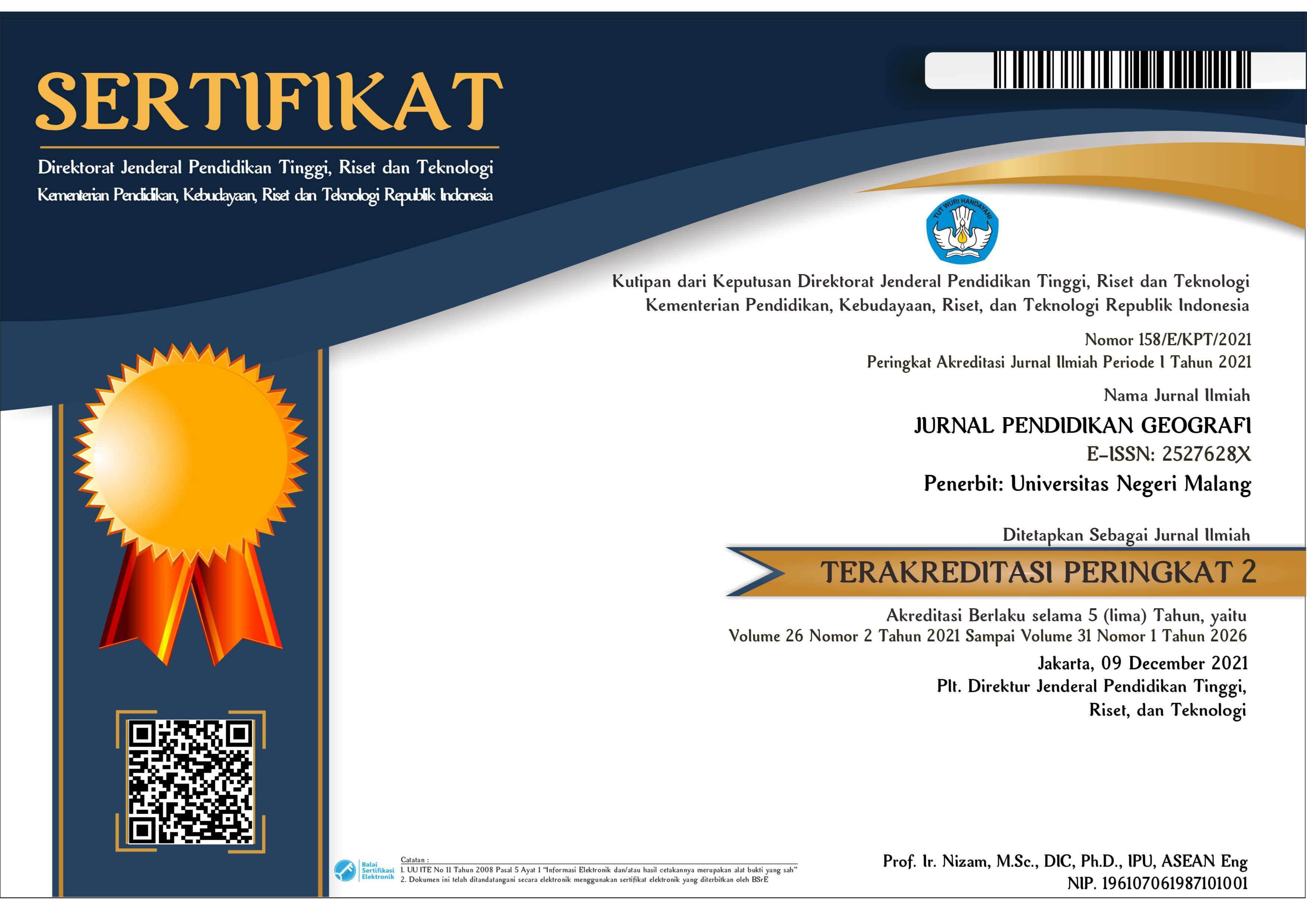The role of a small town in the flow of agricultural commodities with its hinterlands before and after the construction of the Trans Sumatra Toll Road (case study: Kalianda District South Lampung Regency Indonesia)
Abstract
Linkages between rural and urban areas assist numerous regions in a variety of ways. As a meeting place for villages and cities, a small town with hinterlands of agricultural areas acts as a market for village commodities, intermediary markets in larger markets, places for agricultural processing, places for production facilities, and a center for other activities. The construction of the Trans Sumatra Toll Road (JTTS), which crosses Kalianda District as a small town connecting several big cities, allows Kalianda alters its role. This study aims to examine the flow of agricultural commodities in a small town and its hinterlands and analyzed the role of small towns before and after the construction of JTTS. The data analysis was carried out by creating an Origin-Destination Map and providing the description. The results showed that seven agricultural commodities sold in Kalianda Market came from seven sources (origin), while commodities in rural areas had four selling destinations area. The small town illustrates its proper function as an intermediary market for larger markets, centers of health activities, administrative services, and banking services. However, the small town has not been able to play much of a role as an intermediary market for larger markets, rural commodity processing places, and places to find high-order goods. The small town is also incapable of being a destination for the identification of agricultural production facilities. In general, the existence of JTTS does not significantly change the role of small towns.
Keywords
Full Text:
PDFReferences
Adhiatma, R., & Lubis, I. (2020). Perubahan penggunaan/tutupan lahan dan prediksi perubahan penggunaan/tutupan lahan di Kabupaten Lampung Selatan. Jurnal Pengelolaan Sumberdaya Alam dan Lingkungan (Journal of Natural Resources and Environmental Management), 10(2), 234–246.
Akkoyunlu, S. (2015). The potential of rural-urban linkages for sustainable development and trade. International Journal of Sustainable Development & World Policy, 4(2), 20–40.
Ali, B., & Abushad, M. (2014). Agricultural inputs and production: A village level study. Excellence International Journal of Education and Research, 2(4), 459–472.
Amanda, D., Sulistyorini, R., & Ibad, M. . (2017). Kajian moda shuttle wisata dalam mendukung konektivitas antar daya tarik wisata unggulan di Kabupaten Lampung Selatan. Institut Teknologi Sumatera, Lampung.
Bell, D., & Jayne, M. (2009). Small cities? Towards a research agenda. International Journal of Urban and Regional Research, 33(3), 683–699.
Belt, J., Kleijn, W., Chibvuma, P. A., Mudyazvivi, E., Gomo, M., Mfula, C., … Boafo, K. (2015). Market-based solutions for input supply: Making inputs accessible for smallholder farmers in Africa.
Burrahmad, M., Baihaqi, A., Sariyanto, D., & Iskandar, E. (2020). Minat masyarakat terhadap usaha delivery order produk pertanian di Kota Banda Aceh. Jurnal Sosial Ekonomi Pertanian, 16(1), 71–82.
Central Bureau of Statistics of Lampung Province. (2019). Hasil Survei Pertanian Antar Sensus (SUTAS) 2018 Provinsi Lampung seri A2. Lampung: Central Bureau of Statistics.
Central Bureau of Statistics of South Lampung Regency. (2021). Kabupaten Lampung Selatan dalam angka 2021. South Lampung Regency: Central Bureau of Statistics.
Chigusiwa, L., Bindu, S., Muchabaiwa, L., & Mudavanhu, V. (2013). The role of market middleman in the marketing of smallholder holticultur products in Zimbabwe. Greener Journal of Business and Management Studies, 3(8), 369–377. https://doi.org/10.15580/gjbms.2013.8.110113944
Courtney, P., & Errington, A. (2000). The role of small towns in the local economy and some implications for development policy. Local Economy, 15(4), 280–301.
Daldjoeni, N. (2014). Geografi kota dan Desa. Yogyakarta: Ombak.
Davies, S., & Michie, R. (2011). Peripheral regions: A marginal concern. European Policies Research Centre Paper, Vol. 11. European Policies Research Centre, University of Strathclyde, Glasgow.
de Noronha Vaz, T., & van Leeuwen, E. (2016). Towns in a rural world (1st ed.; E. van Leeuwen & P. Nijkamp, Eds.). Routledge.
Douglass, M. (2018). A regional network strategy for reciprocal rural–urban linkages: An agenda for policy research with reference to Indonesia. In The Earthscan reader in rural–urban linkages (pp. 124–154). Routledge.
Gebre, T., & Gebremedhin, B. (2019). The mutual benefits of promoting rural-urban interdependence through linked ecosystem services. Global Ecology and Conservation, 20, e00707.
Harini, R., Yunus, H. S., & Hartono, S. (2012). Agricultural land conversion: Determinants and impact for food sufficiency in Sleman Regency. Indonesian Journal of Geography, 44(2), 120–133.
Holis, Y. M. (2017). Local economic linkages pada kota kecil/menengah sebagai instrumen konsep keterkaitan desa kota (rural-urban linkage). Seminar Nasional Perencanaan Pembangunan Inklusif Desa Kota. Bandung: Institut Teknologi Bandung.
Kamete, A. Y. (1998). Interlocking livelihoods: Farm and small town in Zimbabwe. Environment and Urbanization, 10(1), 23–34.
Kihonge, E. (2017). The Role of Small and Medium Enterprises (SMEs) in small towns in East Africa. In Rural-Urban Dynamics in the East African Mountains (p. 293). Mkuki na Nyota Publishers.
Lazaro, E., Agergaard, J., Larsen, M. N., Makindara, J., & Birch-Thomsen, T. (2017). Rural transformation and the emergence of urban centres in Tanzania. Department of Geosciences and Natural Resource Management, Faculty of Science, University of Copenhagen. IGN Report Vol. October 2017.
Mainet, H. (2017). Town dwellers in their networks: Urban-rural mobility and household strategies in Cameroon. Geografisk Tidsskrift-Danish Journal of Geography, 117(2), 117–129.
Mainet, H., & Edouard, J.-C. (2017). The role of small and medium sized towns in Eastern Africa mountains: new opportunities or challenged position? In Rural-Urban Dynamics in the East African Mountains (pp. 27–45). Mkuki na Nyota Publishers.
Maryadi, M. (2017). Keterkaitan desa kota: Sebuah alternatif pembangunan di wilayah pedesaan. JSTI, 17(2), 1–6.
Nairobi, N. (2013). Dampak saluran distribusi terhadap inflasi: Studi terhadap beberapa komoditas di Kota Bandar Lampung. Jurnal Ekonomi Pembangunan, 2(2), 149–170.
Newman, L., Powell, L. J., Nickel, J., Anderson, D., Jovanovic, L., Mendez, E., … Kelly-Freiberg, K. (2017). Farm stores in agriburbia: The roles of agricultural retail on the rural-urban fringe. Canadian Food Studies/La Revue Canadienne Des Études Sur l’alimentation, 4(1), 4–23.
Niedomysl, T., & Jonasson, M. (2012). Towards a theory of place marketing. Journal of Place Management and Development, 5(3), 223–230.
OECD/WTO. (2019). Facilitating trade through regulatory cooperation: The case of the WTO’s TBT/SPS agreements and committees. Paris: OECD publishing.
Parr, J. B. (2007). Spatial definitions of the city: Four dimensions. Urban Studies, 44(2), 381–392.
Racaud, S., & Mainet, H. (2015). Secondary towns in globalization: challenged position or inconspicuous key role in trade flows? Lessons from East Africa. Articulo-Journal of Urban Research, 12, 01465010.
Ramappa, K. B. (2020, April). Rural India has remained a provider of raw materals so far. Trade Promotion Council of India. Retrieved from https://www.tpci.in/indiabusinesstrade/blogs/rural-india-has-remained-as-a-provider-of-raw-materials-so-far/
Rapsomanikis, G. (2015). The economic lives of smallholder farmers: An analysis based on household data from nine countries. Rome: Food and Agriculture Organization of the United Nations.
Rijanta, R., & Suhardjo, A. J. (2003). Defining rural diversification in a small-farming region: The case of Yogyakarta Special Region. The Indonesian Journal of Geography, 35(2), 107–124.
Rondinelli, D. A. (1979). Planning development projects: Lessons from developing countries. Long Range Planning, 12(3), 48–56.
Rondinelli, D. A. (2019). Applied methods of regional analysis: The spatial dimensions of development policy. Routledge.
Sabet, N. S., & Azharianfar, S. (2017). Urban-rural reciprocal interaction potential to develop weekly markets and regional development in Iran. Habitat International, 61, 31–44.
Sarwade, W. K., & Chetan, S. (2017). Weekly market and rural marketing: An overview. International Journal of Innovative Studies in Sociology and Humanities, 2(7), 8–11.
Sietchiping, R., Kago, J., Zhang, X.-Q., Tuts, R., & Reid, J. (2014). The role of small and intermediate towns in enhancing urban-rural linkages for sustainable urbanization. Regional Development Dialogue, 35, 48–62.
Soekartawi, S. (2002). Analaisis usaha tani. Jakarta: UI Press.
Suharyanto, S. (2020). Rencana zonasi kawasan strategis nasional kawasan Selat Sunda berbasis mitigasi bencana. Webinar Pusat Riset Kelautan “Penataan Ruang Pesisir Berbasis Mitigasi Bencana Di Selat Sunda.” Kementerian Kelautan dan Perikanan.
Sukwika, T. (2018). Peran pembangunan infrastruktur terhadap ketimpangan ekonomi antarwilayah di Indonesia. Jurnal Wilayah dan Lingkungan, 6(2), 115–130.
Swinney, P., McDonald, R., & Ramuni, L. (2018). Talk of the Town. London: Centre for Cities.
Tacoli, C. (1998). Rural-urban interactions: A guide to the literature. Environment and Urbanization, 10(1), 147–166.
Tacoli, C., & Agergaard, J. (2017). Urbanisation, rural transformations and food systems: The role of small towns. Retrieved from www.iied.org/users/cecilia-tacoli
Tracey-White, J. D. (2005). Rural-urban marketing linkages: an infrastructure identification and survey guide (Vol. 161). Food & Agriculture Org.
Ullah, M. A. (2020). Availability of agricultural inputs for crop production: A case study of Dhigalgaon. Bangladesh Journal of Nuclear Agriculture, 30, 95–104.
Vandercasteelen, J., Beyene, S. T., Minten, B., & Swinnen, J. (2018). Big cities, small towns, and poor farmers: Evidence from Ethiopia. World Development, 106, 393–406.
von Braun, J. (2007). Rural-urban linkages for growth, employment, and poverty reduction. International Food Policy Research Institute, Washington, DC, USA. Ethiopian Economic Association Fifth International Conference on the Ethiopian Economy, 7–9. Citeseer.
Wandschneider, T. (2004). Small rural towns and local economic development: Evidence from two poor states in India. International Conference on Local Development, 16, 18. Citeseer.
Wijayanti, M., & Ma’rif, S. (2017). Peran kota-kota kecil dalam peningkatan aktivitas pertanian di Kawasan Agropolitan Merapi Merbabu. Teknik PWK (Perencanaan Wilayah Kota), 6(3), 180–190.
Wisnuwardhani, P., Lestari, D. A. H., & Santoso, H. (2015). Motivasi konsumen membeli kubis segar di Pasar Pasir Gintung Bandar Lampung. Jurnal Ilmu Ilmu Agribisnis: Journal of Agribusiness Science, 3(2), 203–210.
Yanwhardana, E. (2021, April). Mau tahu berapa Km tol yang sudah dibangun Jokowi? CBNC Indonesia. Retrieved from https://www.cnbcindonesia.com/news/20210427123623-4-241192/mau-tahu-berapa-km-tol-sudah-dibangun-jokowi-nih-datanya
Zhang, X., Hu, Y., & Lin, Y. (2020). The influence of highway on local economy: Evidence from China’s Yangtze River Delta region. Journal of Transport Geography, 82, 102600.
DOI: http://dx.doi.org/10.17977/um017v28i22023p107-133
Refbacks
- There are currently no refbacks.
Copyright (c) 2023 Jurnal Pendidikan Geografi: Kajian, Teori, dan Praktek dalam Bidang Pendidikan dan Ilmu Geografi

This work is licensed under a Creative Commons Attribution-ShareAlike 4.0 International License.
Jurnal Pendidikan Geografi: Kajian, Teori, dan Praktek dalam Bidang Pendidikan dan Ilmu Geografi is licensed under Creative Commons Attribution-ShareAlike 4.0 International License,
JPG Indexed By:
View My Stats








12.png)
